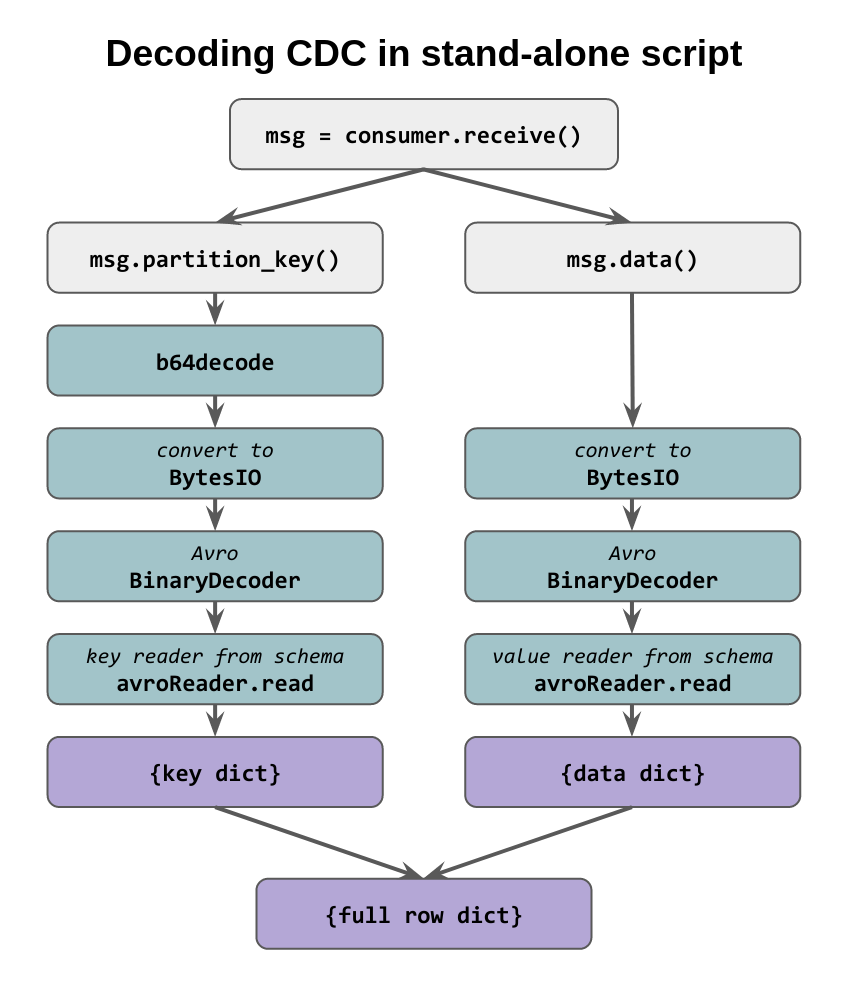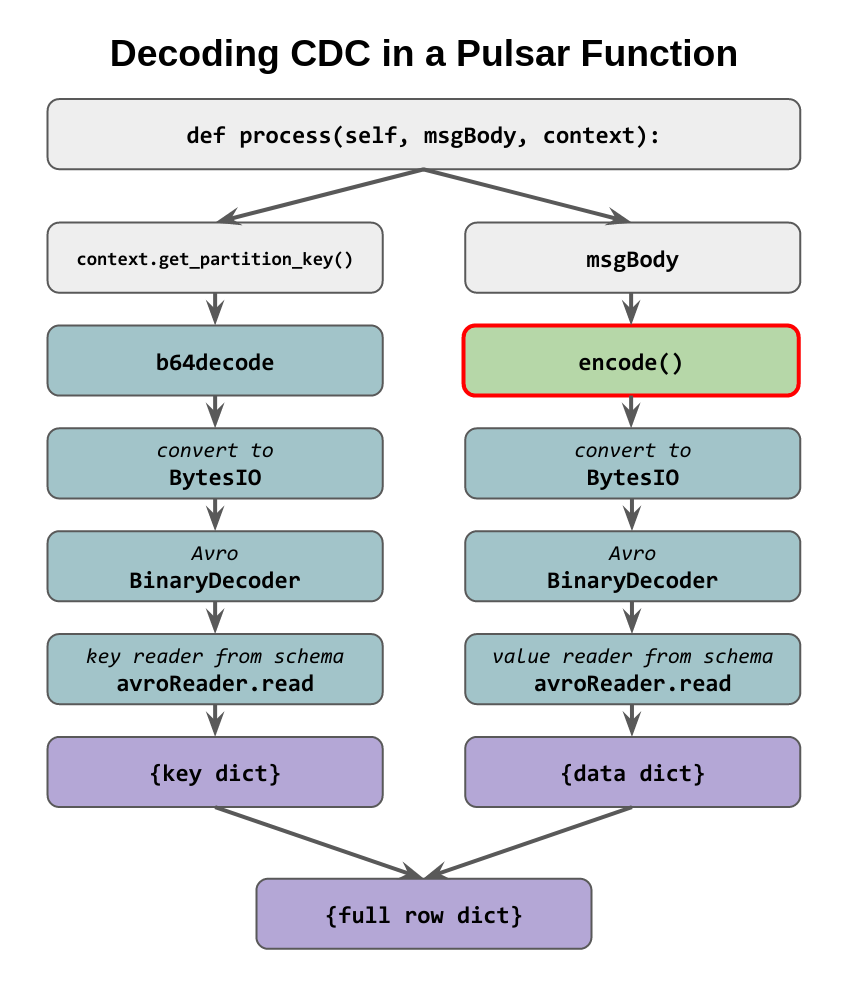We have CDC enabled from an Astra DB table to an Astra Streaming topic and we want to decode the content of each event to have it e.g. as a plain JSON.
We want to do it in Python.
We want to be able to do it both in a standalone consumer Python script and within a Streaming Function.
First do it with a standard Python script, then do it within a Streaming Function.
(In particular, the latter will be used to "de-schemaify" the CDC topic, i.e. for each incoming Avro-schemaful CDC event we want to publish a plain-JSON counterpart to another, schemaless topic. This is but one of the many possible applications of the findings presented here.)
Prepare for a small surprise that arose while completing this exercise, a small difference between the standalone-script and the pulsar-function encoding schemes that, as always with Pulsar functions, was somewhat cumbersome to track and debug.
Note that a fixed starting point is the schema structure for creating the Avro decoders. Two such structures exist, one for the "data columns" and one for the primary key stuff, and they can be read off the Astra Streaming UI (auto-populated once at least one CDC event goes through).
The example CDC consumer code on the Streaming site does query dynamically and endpoint that gives the schema for the table, but then does some cleanup of it, etc. Or at least it appears to work like that: I never got the example to work as is and had to fiddle quite a bit, ending up copypasting the schema JSON manually into my project.
Alternatively, you can manually build the schema descriptor structure,
if you dare (keeping unions with Nones into accunt and the like.
Good luck).
We need a table in a keyspace and a Streaming tenant in the same cloud provider and region. Here:
keyspace = track3demo
tenant = track3demo
Provider/region = GCP / useast1
Table:
CREATE TABLE track3demo.reviews (
hotel TEXT,
id TIMEUUID,
reviewer TEXT,
body TEXT,
is_valid BOOLEAN,
score INT,
PRIMARY KEY ( (hotel), id )
) WITH CLUSTERING ORDER BY ( id DESC );
Typical insert (to test it all later):
INSERT INTO track3demo.reviews
(hotel, id, reviewer, body, is_valid, score)
VALUES
('Fungal Resort', now(), 'Geppo', 'The cockroaches are kind and helpful', true, 6);
Enable CDC: you do it on the database, picking the target tenant and the source keyspace/table. Refresh the page, CDC should become "Running" immediately.
Now write a row to DB for the schema to be auto-detected in the topic (very useful later).
Either by inspecting the autogenerated track3demo/astracdc/data-BLABLABLA-track3demo.reviews
CDC topic, or magically because you are an Avro level-12 sorcerer, retrieve two JSON
descriptions for the partition-key columns and the data-columns of
the table.
(Incidentally, if you go to the "Try me" feature it 403s.)
Key and values schemas are separate, corresponding to how the CDC messages keep the former in the "(streaming) partition key" and the latter in the "data" of the CDC events it produces.
You can strip the namespace and doc fields away to make the schemas slimmer,
they don't actually do anything for us. The final schema docs, recast as Python dictionaries,
look like this (note there are several Python None values but also "null" string literals around):
keySchemaDict = {
"type": "record",
"name": "reviews",
"fields": [
{
"name": "hotel",
"type": "string"
},
{
"name": "id",
"type": [
"null",
{
"type": "string",
"logicalType": "uuid"
}
],
"default": None
}
]
}
valueSchemaDict = {
"type": "record",
"name": "reviews",
"fields": [
{
"name": "body",
"type": [
"null",
"string"
],
"default": None
},
{
"name": "reviewer",
"type": [
"null",
"string"
],
"default": None
},
{
"name": "is_valid",
"type": [
"null",
"boolean"
],
"default": None
},
{
"name": "score",
"type": [
"null",
"int"
],
"default": None
}
]
}You need these (preferrably in a Python virtual environment).
avro==1.11.1
pulsar-client==2.10.2
At the time of writing, these are the correct versions to use.
Grab the following on Astra Streaming UI:
service_url, something like"pulsar+ssl://pulsar-gcp-useast1.streaming.datastax.com:6651";topic_name, looking like"track3demo/astracdc/data-0114844e-720a-4487-92d4-4c07ada112e3-track3demo.reviews"(use the fully-qualified name here);token(this is secret), a long long string of characters.
Put these in your copy of standalone/cdc-reader.py.
The program is now good to run. After launching
python standalone/cdc-reader.py,
try to insert a row in the table and watch.
Notice that as said earlier the script collates the columns found in the message partition key and in the "data" (i.e. the body), to reconstruct the whole written row.
The way these two parts are encoded is not entirely trivial: namely,
msg.partition_key() is a 'string' (a b64-encoded string)
msg.data() is 'bytes'
So the (rather layered!) chain of decodings look like:
Also note that many CQL data types get "trivialized" to simpler types: for
instance, uuids become simple strings. This comes handy since we aim at
producing a JSON, but still is worth noting. No tests have been done on date/time types
or other stuff (yet).
Just create a topic in the same tenant, any namespace is fine.
Here it will be the default/dummy topic.
We now want the same logic to work in a Pulsar function, with the goal of seeing the row JSON documents being published to the "schemaless topic" just created, for any downstream consumption.
Besides the task of correctly packaging the required dependency (avro)
for use within the function, as we'll see, unexpected differences arise in how
the parts of the row are (accessed, and) encoded.
We will upload a zip-file
containing the function definition (as a class)
and any required dependency in the form of a Python wheel (*.whl file).
The Astra Streaming
docs page
seem to reassure that this is the way.
There are no ready-made wheels for Avro, so as instructed here we simply run
pip wheel avro==1.11.1
which indeed creates the wheel for Avro.
The structure of the zip file is seen in the reference example on the Pulsar docs and will be as follows:
deschemaer.zip <====> .
└── deschemaer
├── deps
│ └── avro-1.11.1-py2.py3-none-any.whl
└── src
└── deschemaer.py
Note: such a zip file, with
deschemaerin it, can be created in thefunctiondirectory with the commandzip -r deschemaer.zip deschemaer.
In the function code, we can now happily use statements such as import avro.schema and the like.
We have to package the message processing as the process() method of a
class extending pulsar.Function in order to be able to access the
context,
which is how you read the partition key for the incoming message.
So the class will begin like this:
class Deschemaer(Function):
def process(self, msgBody, context):
msgPK = context.get_partition_key()
...
...
...For the whole code and the ready-made zipfile, look into the function directory.
To set up the function one needs to specify the source and destination topics when uploading the zip file and that's it.
There's a subtle difference with the stand-alone script:
the message body is not bytes this time, rather it is a string
and as such it must be additionally .encode()d before the
rest of the transformations.
In short:

